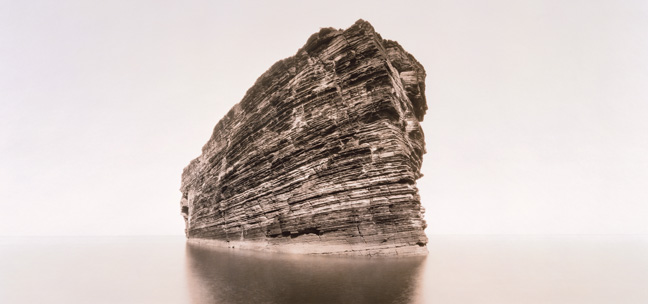Michael Hoppen Gallery
3 Jubilee Place, Londyn
15 September – 31 October 2004
David Parker
Sirens

David Parker Sirens III, 2003
172 x 101.5 cm Toned silver gelatin print from an edition of 10
© David Parker, courtesy of Michael Hoppen Gallery
IN SEARCH for solitary monumental rock stacks, David Parker has been exploring unihabited coastal areas. Travelling in his camper van the photographer carries a custom made large format panoramic camera, a tripod and a darkroom. The result of his recent journeys are 13 large format, panoramic photographs, 11 of which are currently exhibited on the top two floors of the Michael Hoppen Gallery. Impressive in scale, almost two metre long toned silver gelatin prints demonstrate the high degree of Parker’s competence as a photographer and master printer. They also reflect his fascination with 19th Century landscape photography, especially works by Carleton Watkins and Timothy O’Sullivan. Parker has embraced slow and rather cumbersome photographic methods used in the 19th Century, such as long, eight minute exposures and a wet collodion process. However, he uses old techniques selectively, altering and adopting them to suit his particular aesthetic. Parker’s decision to include neither the 19th Century’s diminutive lone figure nor the cloudscape differentiates his work from historical practice.
By simplifying detailand texture of the sky and water, the solitary rocks and their rugged surfaces, by contrast, appear surreal. The panoramic scope of these images, the overwhelming silence they seem to project and the stillness of the smooth, milky space envelops the viewer making the encounter with the grand and surreal forms both magical and intimate. Mesmerising like Homeric Sirens, they command full attention transporting the viewer into a different world.
Parker has always been interested in the relationship between mythology and landscape, especially natural forms that have been endowed with spiritual meaning. In some ways his ‘Sirens’ seem to be a continuation of the tradition of romantic landscape painters, such as Caspar David Friedrich, who filled his mountains with spiritual and religious significance. For Parker, it is the sea which becomes symbolic of the psyche’s deep layers, with monumental, solitary rocks being guardians as well as envoys from another world.

David Parker Sirens XIII, 2003
172 x 101.5 cm Toned silver gelatin print from an edition of 10
© David Parker, courtesy of Michael Hoppen Gallery
These images acquire archetypal, inutterable meanings, serving contemplation, not documentation. For this reason the names and exact locations of these stacks remain secret. Their anonymity liberates the viewer from the usual desire to reconnect the image with the physical reality it represents. Instead, the placelessness of the images and their uncanny visual character lead us on an unknown journey.
David Parker’s “Sirens,” like his previous series, “The Phenomenal World” has a different space and time dimension than the increasingly popular, fast and easily accessible digital photography. Photography as practised by Parker requires a degree of involvement in the creation of a photographic image which is not often encountered today. Time and solitude is essential in his search for the subject of his images. A meditative pace is required for working with a large format camera. The photographer fully participates in every stage of the process including designing equipment and filmstock. Such complete involvement in every detail of the process aptly translates into the aesthetic of the image. Time and space etched into his photographs are a luxury, which at the beginning of the 21st Century we rarely experience.
Basia Sokolowska
See also:
Copyright © 1997-2025 Marek Grygiel / Copyright for www edition © 1997-2025 Zeta-Media Inc.